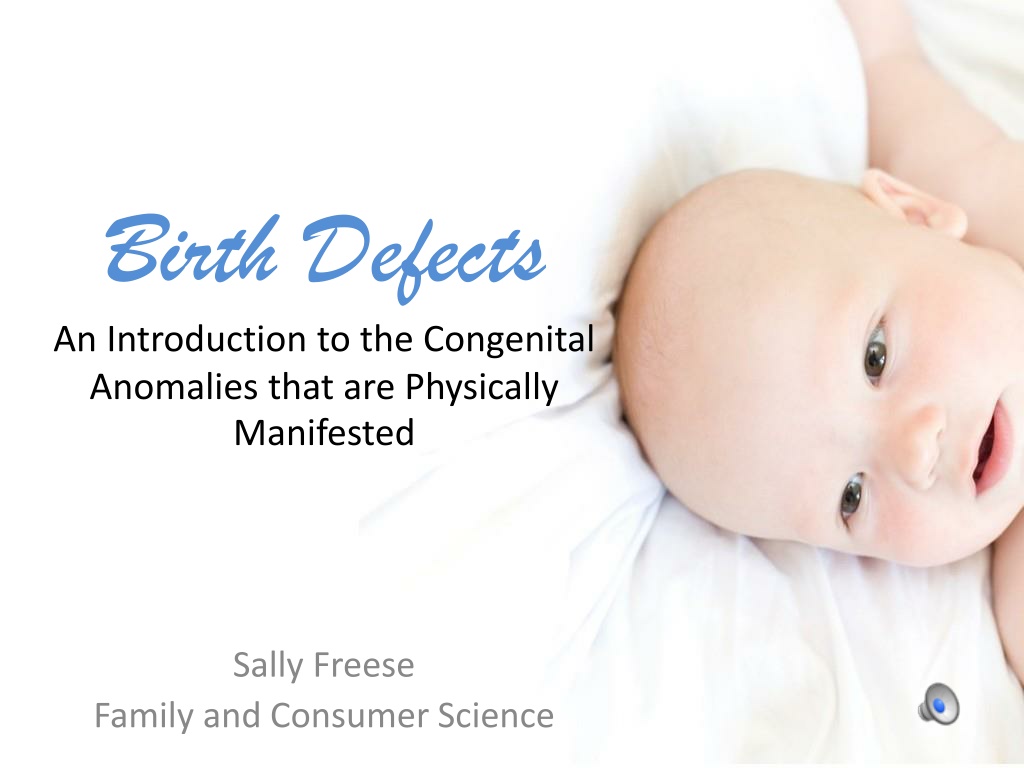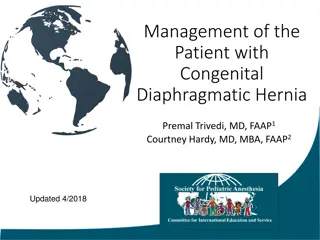Understanding Birth Defects: An Overview of Congenital Anomalies
Birth defects refer to abnormalities present in babies at birth, regardless of genetic or prenatal causes. They affect 2-3% of babies in the US, making them a leading cause of infant mortality. Structural defects like cleft lip/palate, spina bifida, and club foot can impact a child's health and development. Early detection and intervention are crucial in managing conditions like congenital hip dislocation and hypothyroidism. Increasing awareness and preventive measures such as folic acid supplements can help reduce the incidence of birth defects.
Download Presentation

Please find below an Image/Link to download the presentation.
The content on the website is provided AS IS for your information and personal use only. It may not be sold, licensed, or shared on other websites without obtaining consent from the author. Download presentation by click this link. If you encounter any issues during the download, it is possible that the publisher has removed the file from their server.
E N D
Presentation Transcript
Birth Defects An Introduction to the Congenital Anomalies that are Physically Manifested Sally Freese Family and Consumer Science
Definition & Statistics Any defect present in a baby at birth, irrespective of whether the defect is caused by a genetic factor or by prenatal events that are not genetic. In the United States, 2-3% of babies are born with a medically significant birth defect. Birth defects are now the leading cause of infant mortality in the United States. Birth defects are present in one of every three babies that die in the United States. MedicineNet.com
Structural Defects Cleft lip/palate Spina bifida Club foot Congenital Dislocation of the Hip Congenital Hypothyroidism Cerebral Palsy
Cleft Lip/Palate caused by abnormal facial development in utero affects a child s speech and ability to feed may be surgically corrected
Spina Bifida caused by incomplete closing of the embryonic neural tube (spinal cord) the opening can be surgically closed, but may not restore function and the child may have to use a wheelchair for life the incidence of spina bifida can be decreased by up to 70% when daily folic acid supplements are taken prior to conception
Club Foot the foot is inverted at the ankle may affect one foot or both may be corrected by physical therapy, bracing or casting, or surgery
Congenital Dislocation of the Hip the child s hip is not in the correct place this must be detected early to avoid permanent damage to the leg treatment with several weeks of casting
Congenital Hypothyroidism (Cretinism) condition of severely stunted physical and mental growth due to untreated congenital deficiency of thyroid hormones, usually due to the mother having low thyroid hormones during pregnancy
Cerebral Palsy thought to be caused by problems with intrauterine development this disorder affects a child s muscles, thus affects the ability to move and balance these children can also experience seizures, eating problems, mental retardation, learning disabilities, or behavioral disorders
Genetic Disorders Down Syndrome Prader-Willi Syndrome Fragile X Syndrome Muscular Dystrophy Marfan Syndrome Achondroplasia
Down Syndrome caused by an extra 21st chromosome (these kids have 3, normal kids have 2) this will affect the child s cognitive ability and physical growth these children have a higher risk for developing serious health problems (heart defects, obesity, thyroid dysfunction, etc.)
Prader-Willi Syndrome a disorder that involves seven genes these children have low muscle tone, short stature, incomplete sexual development, cognitive disabilities, problem behaviors, and a chronic feeling of hunger that can lead to excessive eating and life- threatening obesity
Fragile X Syndrome caused by genetic mutation this results in a spectrum of intellectual disability ranging from mild to severe as well as physical characteristics such as an elongating face, large or protruding ears, and behavior characteristics (social anxiety, involuntary movements)
Muscular Dystrophy these children have progressive skeletal muscle weakness, defects in muscle proteins, and death of muscle cells and tissue boys are affected more than girls because boys are more likely to inherit the diseased genes
Marfan Syndrome genetic disorder that affects the body s tissues it affects all parts of the body, including the heart, lungs, eyes, spinal cord, skeleton, and mouth the extremely long limbs are the most prominent feature
Achondroplasia (Dwarfism) caused by a change in the DNA for growth factor genes these children have short stature average adult height is 4 ft 3 in for males and 4 ft 1 in for females
Additional Birth Defects There are many, many more types of birth defects that affect our nation s children. However, these defects may not necessarily manifest themselves through physical characteristics. These include, but are not limited to: congenital heart defects, defects of the gastrointestinal tract, cystic fibrosis, sickle cell anemia, phenylketonuria, Tay-Sachs disease, and more. These birth defects typically do not result in changes of the child s physical appearance until late stages of the disease. However, they are just as critical to a child s health and must be managed by a specialized team of healthcare providers.























